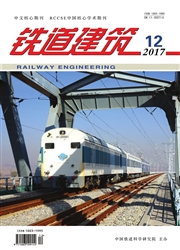

 中文摘要:
中文摘要:
我国既有铁路隧道整体道床下沉、翻浆冒泥等病害严重影响线路平顺性与服役状态,采用调整扣件等常规措施难以根治,无法保障线路安全运营。本文以太岚铁路柏崖头隧道病害整治工程为例,提出了"抬—注—锚"复合整治技术。该技术采用液压同步控制系统精确控制整体道床的抬升过程,在施工过程中与后续注浆和锚固措施紧密配合。首先采用有限元数值模拟,对比分析道床中部抬升、道床两侧顶升、边顶中抬三种方案,确定了边顶中抬为实施方案;然后介绍了整体道床下沉病害整治方案的实施过程及要求;最后通过施工监测对整治效果进行验证。结果表明:经"抬—注—锚"复合整治技术处理后,整体道床的最大下沉量由整治前的39.8 mm降低为1.9 mm,差异沉降由整治前的8.33‰减少为0.47‰,整治效果良好。
 英文摘要:
英文摘要:
Tunnel monolithic concrete bed subsidence of some existing railway lines and the diseases such as frost boiling and mud pumping seriously affected the railway line smoothness and service status,which couldn't be cured by conventional measures including adjusting fasteners,and railway line safety operation couldn't be assured.Taking the disease remediation project of Baiyatou tunnel in Tailan railway as an example,the composite remediation technology of lifting-grouting-anchorage was presented in this paper,which adopted hydraulic synchronous control system controlling the lifting process of monolithic concrete bed and closely matched with the following grouting and anchorage measures.By using finite element numerical simulation,three schemes of lifting in the middle jacking on both sides and jacking on side-lifting in the middle were compared and analyzed and the last scheme was selected,implementation process and requirements of disease remediation plan for monolithic concrete bed subsidence were introduced,and the remediation effectiveness was verified through the construction monitoring.Results showed that the maximum subsidence of monolithic concrete bed was decreased from 39.8 mm to 1.9 mm and differential settlement was from 8.33‰ to 0.47‰ after composite remediation technology treatment of lifting-groutinganchorage,which means the remediation effect was good.
 同期刊论文项目
同期刊论文项目
 同项目期刊论文
同项目期刊论文
 期刊信息
期刊信息
